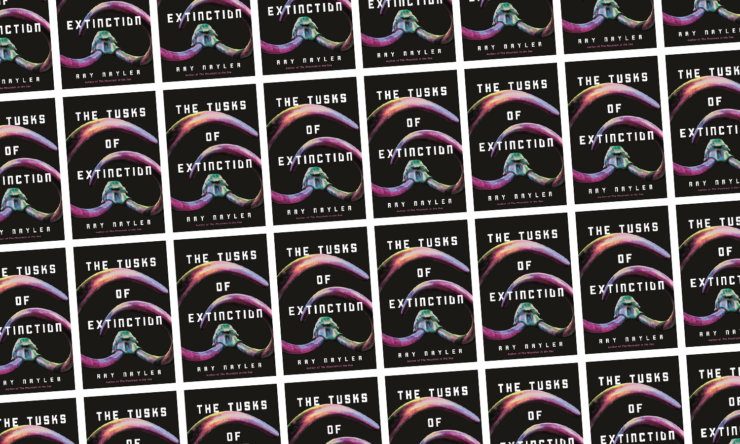When it comes to the de-extinction of the mammoth, Ray Nayler’s eco-thriller The Tusks of Extinction takes a similar approach to Michael Crichton’s Jurassic Park: The Ice Age creatures are dug out of the frozen earth, their DNA extracted and mixed with that of elephants, the embryos birthed by the last few elephants living in captivity generations after they themselves were hunted nearly to extinction. But no wild elephants have roamed the planet for a long time at the start of this ambitious if overstuffed novella. The next best thing? Dr. Damira Khismatullina, the foremost expert on the species.
The only wrinkle is that Damira died a hundred years ago, brutally murdered by the poachers she attempted to protect the last elephants from. The solution, then, exceeds Crichton’s resurrection by embedding Damira’s consciousness into the mammoth matriarch, so that she might teach the nascent herd at least a fraction of what was long-ago pure instinct. Though this seems like a rather straightforward premise, Nayler layers it with several more subplots that simultaneously distract from Damira’s fascinating and noble undertaking yet nonetheless provoke thought, making for an expansive yet frustratingly brief tale.
The best way to take this story is in context with similar works. For one, it’s a lovely companion piece to Brooke Bolander’s 2018 novelette The Only Harmless Great Thing, which dances between an alternate-history 20th-century linking Topsy the elephant and the Radium Girls, and a future in which humans implore sentient elephants to solve the atomic priesthood problem. Both stories center on an impassioned woman with an expertise in elephants—idealistic scientist Kat, versus doctor and anti-poaching activist Damira—begging these wise creatures for the nigh-impossible, more for humans’ sake than for their own.
Like Harmless, Tusks never lets the reader forget that humans will always be at least one degree removed from these magnificent creatures. Kat can only approximate a trunk’s fluid signing in Proboscidian; Damira’s expertise, though as rare and treasured as ivory, will never transcend the purely academic. At least, until the hypothetical becomes the new reality, and her lived experience as a mammoth sets a new precedent. But while tapping into ancient herd dynamics falls squarely on Damira’s shoulders, it is not her sole responsibility to actually keep the mammoths alive; that is complicated by the human greed that muddies the noble mission of the geneticists that resurrected the mammoths, and her, a century after her death.
Buy the Book


The Tusks of Extinction
That massive time-jump is important to the premise, cementing Damira’s expertise, but has little bearing on the plot. Far-future Russia seems not that different from near-future, in that both have developed thought-related technology beyond our current scope. So think less that it’s Nayler covering such a broad span of time in 112 pages and instead inhabiting two fixed points that happen to be a hundred years apart. In fact, that seems to be by design with how the story sets itself up, introducing human Damira and mammoth Damira almost interchangeably, until you catch on to the different ways in which she inhabits the Kenyan savannah versus the Siberian steppe.
The hop-skips of both perspective and timeline are at first difficult to adjust to; there is so much information to impart that it would initially seem more useful to lay it out more chronologically. However, it soon becomes clear that this style of semi-free-association—especially for Damira, switching between mammoth and human recollections from the barest whiff of scent—mimics the elephant’s memory web. Once you settle into that rhythm, Tusks charges ahead, albeit in an unexpected direction.
While I expected such a slim story to occur entirely within Damira’s consciousness, she actually shares about equal space with two other characters: Syatoslav, the teenage son of poachers, and Vladimir, whose rich husband Anthony invites him on a secret billionaire hunting trip—all with the mammoths in their sights. By exploring these young men’s relative dependence on fathers and spouses, whether through financial or age-related autonomy, as well as their personal ambivalence to the cruelty of hunting, Nayler makes these supposed antagonists shockingly sympathetic. After all, each is a member of his own particular tribe, whether born or married into that family; yet neither has enough control to break away from the herd—at least not before this moment of confrontation on the frigid steppe.
Furthermore, within all of these pseudo-herds there are tiers, based on class disparities and self-perceived issues of importance to history. There are the people like Damira, whose memory is deemed important enough to be uploaded to the Moscow Institute’s Mind Bank, while her former schoolmate and friend Yelena is just the tech grunt pressing buttons. (Yet let’s not put aside the fact that one of Damira’s most indelible human memories is trading backstories with another elephant activist, Wamugunda, and her shame at him “coming from somewhere” (his upbringing in Kenya) and her “coming from nowhere” (she loved elephants as a child).) It’s another thing that the intellectual class has in common with the poachers; the latter realize that while they do the grisly work of killing the animals, they are merely delivering to their rich buyers what they already own, i.e., the tusks that they won’t dirty their hands to get said hands on.
This ever-present theme of imbalanced payment grimly illustrates the losing endeavor of the cruelly-named ivory trade; at least one human always loses so that another human may gain nothing more than a trophy. It’s very telling that the key human trait that Damira teaches the mammoths is revenge, and that she’s so mystified to discover that they learn mercy all on their own.
Nayler withholds some key information about the end of Damira’s human life, which will recontextualize the aforementioned teachings and discoveries that mark the next stage for her herd. Similarly, he reveals some fascinating bits of worldbuilding via technology that many a reader would likely want another whole novella about: more about the Mind Bank as a system and an archive, for one; and a century later, the Alexander, a seashell-shaped device that allows its wearer to project their thoughts one-way to eager listeners. He’s woven a fascinating web yet dips into so many different pockets that the end result is certainly affecting but feels unfinished.
The Tusks of Extinction is available from Tordotcom Publishing.
Natalie Zutter is a writer and pop culture critic based in Brooklyn. Talk futuristic mind-bending stories with her on Twitter and Bluesky!










